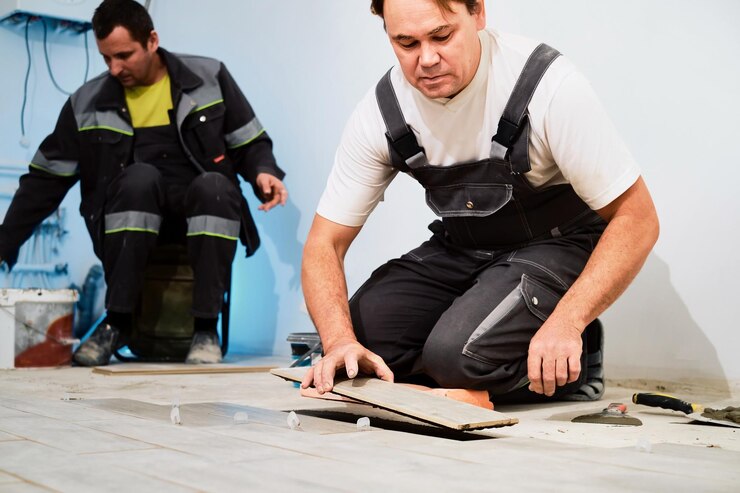
Installation of tile can change a place giving longevity, style, and utility. A perfect tile work, however, calls for accuracy, meticulous attention to detail, and a complete awareness of the installation procedure. Whether you are doing the project yourself or working with a tile installation company, it is important to be aware of typical errors that could produce disappointing results. Some of these errors will be discussed below together with advice on how to prevent them so your tile job turns out perfectly.
1. Inappropriate Surface Polishing
Ignorance of appropriate surface preparation is one of the main errors committed during tile installation. The surface onto which the tiles are being laid has to be dry, clean, and smooth. Any dirt, dust, or trash might cause the glue to bond incorrectly, resulting in tiles that might move or come free over time.
How to avoid starting the tile installation on a surface that is not completely clean? Make sure the surface you are tiling over is in good shape if it is already existent. For instance, look for any mildew or mold in a bathroom or kitchen before laying tiles there and treat the surface. Use a leveling compound to produce a smooth base if your surface is uneven.
2. Using the incorrect adhesive
Another typical error is choosing the incorrect kind of glue for the surface and the tiles. Different tiles call for different kinds of adhesives, so the incorrect choice could cause inadequate bonding and early tile breakdown.
How to avoid choosing an adhesive based on manufacturer advice or consulting a tile installation company? Ceramic tiles might, for instance, call for a different adhesive than genuine stone tiles. Furthermore, a waterproof adhesive is crucial in damp places like kitchens and bathrooms to stop water damage and guarantee tile lifetime.
3. Ignoring the Layout Plans
Plan the layout first, then begin laying the tiles. Many do-it-yourselfers start the installation without thinking through the tile arrangement, which produces ugly results. Tiles might, for example, turn out misaligned or include oddly carved edges.
Before using adhesive, give your tiles some time to dry-fit. Find the middle of the wall or room first, then work outward to guarantee equal tile distances. Keeping regular grout lines requires tile spacers. Ahead of time planning guarantees a professional-looking output.
4. Not Correctly Using Tile Spacers
Maintaining equal grout lines requires little, sometimes disregarded instruments called tile spacers. Without them, the tiles can wind up either too far apart or too close together, therefore influencing the appearance and purpose of the tile project.
Use tile spacers always during installation to avoid mistakes. The grout line size you desire determines the spacers’ size as well. A 1/8-inch spacer is perfect for most ordinary tiles; but, for bigger tiles you could require more spacers. Make sure the grout lines are constant during the whole installation and that the spacers are positioned equally.
5. Improper Cutting of Tiles
Correct Cutting of Tiles Cutting tiles can be difficult, and incorrect cuts may produce tiles that don’t fit well or sharp edges. This is particularly frequent while cutting tiles to fit corners or walls.
Use a tile cutter, wet saw, or tile nippers—the proper instruments for cutting tiles. First practice on a scrap piece of tile if you’re not sure how to create exact cuts. Measure carefully and cut precisely when you cut tiles for corners or edges to prevent gaps that might be difficult to close.
6. Not Sealing the Grout or Tiles
If tiles—especially natural stone tiles—are not sealed, they can collect moisture and over time become discolored. Furthermore porous, grout can draw dirt and moisture, which would cause discoloration and possible mold development should inadequate sealing be used.
Apply a premium sealer to both the tiles and the grout lines once the tiles have been laid and the grout has cured. In damp places like kitchens or bathrooms, this stage is very crucial. Not only will sealing your tiles and grout help to prevent damage, but it will also simplify maintenance and cleaning of them.
7. Denying Appropriate Drying Time
Especially with regard to drying time, rushing through the tile installation procedure can result in errors. Should you not give the adhesive and grout adequate time to set before walking on or utilizing the tiled area, tiles may move, break, or loosen.
Avoid: Use the advised drying times suggested by the grout and adhesive manufacturer. Usually, you should wait at least 24 hours before stepping on the tiles and many days before completely using the space. Being patient at this point will help to guarantee the lifetime of your tile installation.
8. Dealing with Plumbing Problems Ignorance
Ignoring plumbing concerns might lead to major problems down the road if you are laying tiles in a place including plumbing, such a bathroom or kitchen. Leaks or clogged drains, for instance, could compromise your tiles and grout, requiring expensive repairs.
Consult a plumber Martinsburg WV before starting your tile installation; particularly if you are working around pipes or fixtures, this is advisable. Before you start with installation, a skilled plumber may look over the area for any possible problems and make required repairs. This guarantees that issues connected to water will not compromise the integrity of your tiles.
Conclusion
Although tile installation is an investment in the appearance and functionality of your house, it’s important to prevent typical blunders that could cause expensive repairs or early wear and tear. You can guarantee a beautiful, long-lasting tile installation by carefully preparing the surface, choosing the appropriate adhesive, designing your layout, utilizing spacers correctly, making accurate cuts, sealing the tiles, allowing appropriate drying time, and handling plumbing concerns.
Whether you are starting a do-it-yourself project or working with a tile installation business, awareness of these possible hazards can help you avoid problems and get the intended professional finish.